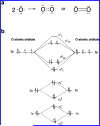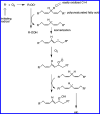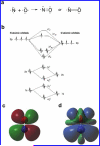Small molecule signaling agents: the integrated chemistry and biochemistry of nitrogen oxides, oxides of carbon, dioxygen, hydrogen sulfide, and their derived species
- PMID: 22263838
- PMCID: PMC4061765
- DOI: 10.1021/tx2005234
Small molecule signaling agents: the integrated chemistry and biochemistry of nitrogen oxides, oxides of carbon, dioxygen, hydrogen sulfide, and their derived species
Abstract
Several small molecule species formally known primarily as toxic gases have, over the past 20 years, been shown to be endogenously generated signaling molecules. The biological signaling associated with the small molecules NO, CO, H₂S (and the nonendogenously generated O₂), and their derived species have become a topic of extreme interest. It has become increasingly clear that these small molecule signaling agents form an integrated signaling web that affects/regulates numerous physiological processes. The chemical interactions between these species and each other or biological targets is an important factor in their roles as signaling agents. Thus, a fundamental understanding of the chemistry of these molecules is essential to understanding their biological/physiological utility. This review focuses on this chemistry and attempts to establish the chemical basis for their signaling functions.
Figures

















References
-
- Moncada S, Palmer RMJ, Higgs EA. Nitric oxide: physiology, pathophysiology and pharmacology. Pharmacol. Rev. 1991;43:109–141. - PubMed
-
- Li L, Moore PK. An overview of the biological significance of endogenous gases: New roles for old molecules. Biochem. Soc. Trans. 2007;35:1138–1141. - PubMed
-
- Kashiba M, Kajimura M, Goda N, Suematsu M. From O2 to H2S: A landscape view of gas biology. Keio J. Med. 2002;51:1–10. - PubMed
-
- Pryor WA, Houk KN, Foote CS, Fukuto JM, Ignarro LJ, Squadrito GL, Davies KJA. Free radical biology and medicine, it's a gas, man. Am. J. Physiol., Regulatory, Int. Com. Physiol. 2006;291:491–511. - PubMed
-
- Fukuto JM, Collins MD. Interactive endogenous small molecule (gaseous) signaling: Implications for teratogenesis. Curr. Pharm. Des. 2007;13:2952–2978. - PubMed
Publication types
MeSH terms
Substances
Grants and funding
LinkOut - more resources
Full Text Sources
Other Literature Sources
Miscellaneous

